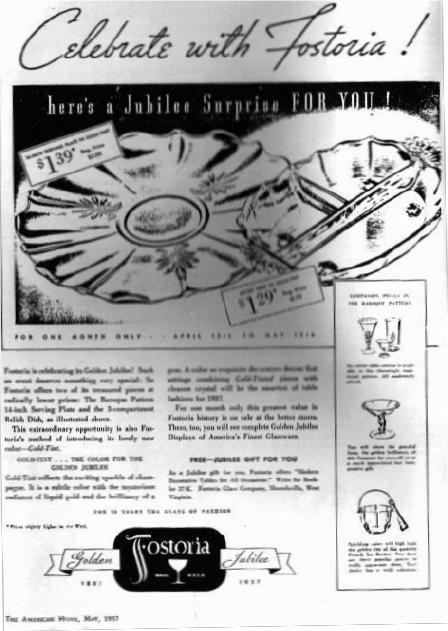National Depression Glass Association
Preserving America's Glass Manufacturing Heritage
Fostoria's "Baroque" Pattern
by Virginia Scott
Rainbow Review Glass Journal - August 1977
In 1936 Fostoria Glass Company introduced their No 2496 Line, the
lovely "Baroque" pattern. Baroque is a rather simple molded design
which features a slightly scalloped or wavy edge and vertical optic
 ridges. A fleur-de-lis design is molded into most of the pieces, giving
the pattern a look of elegant simplicity.
ridges. A fleur-de-lis design is molded into most of the pieces, giving
the pattern a look of elegant simplicity.
The Baroque ad which appears at the end of the article, was found in many of the leading magazines of 1937. That was the year that Fostoria celebrated their 50th anniversary in business with a "Golden Jubilee." According to the ad, a new color, "Gold Tint," was developed in honor of the anniversary and was designated as the official color for the Golden Jubilee. "Gold Tint," the ad announces, "reflects the exciting sparkle of champagne. It is a subtle color with the mysterious radiance of liquid gold and the brilliancy of a gem." (That reminds one of the poetic language used in the earliest Fostoria ads, doesn't it?) The two pieces of "Gold Tint" Baroque shown in the ad, the 14-inch serving plate and the 10" three-sectioned relish dish, were, according to the ad, radically reduced in price for the Golden Jubilee and in order to introduce the "Gold Tint" color.
The Baroque pattern was introduced in 1936 and made until 1966. During this time period it was made in many pieces and in several colors. Azure blue was made from 1936 to 1944; Topaz from 1936 to 1938; Gold-Tint from 1937 to 1944; and odd pieces in Ruby from 1936 to 1939. Handles on Baroque cups, pitchers, sugars, nappies and some other bowls are simple rounded and notched scrolls. Fancier handles, which are made in a variation of the fleur-de-lis design, appear on other pieces, notably large bowls, trays and relish dishes. A similar fleur-de-lis variation is also used in the stems of some compotes, as the finial of covered dishes and compotes, and on candleholders. (See ad.)
The No. 2496 Baroque blank was used for many of Fostoria's plate etchings. You may find pieces of "Lido", "Shirley", "Arcady" and Corsage" etched on the Baroque blanks. Three of Fostoria's longest-lived dinnerware patterns, "Navarre", "Meadow Rose" and "Chintz" will also be found on the Baroque blank. "Meadow Rose" was introduced in 1937 and discontinued around 1973. It was made in Azure from 1937 to 1944. "Chintz" was introduced in 1940 and discontinued around 1975 or 1976. "Navarre" was introduced in 1931 and is stIll being made in 1977. "Navarre" stemware, which is etched on the No. 60l6 blank, is at present being made in crystal, blue and pink. It should be mentioned that some pieces of the patterns named above were etched on other Fostoria blanks as well.
For several years, Fostoria Glass Company and Pickard China Company have put out brochures which picture crystal and china patterns. The 1977 brochure shows a "Navarre" china pattern. This pattern is a rather faithful copy of the "Navarre" etching and is done in shades of dark blue and red with touches of yellow and green.
[Reference: Weatherman, Fostoria: Its First Fifty Years. The ad is published by courtesy of Fostoria Glass Company.]